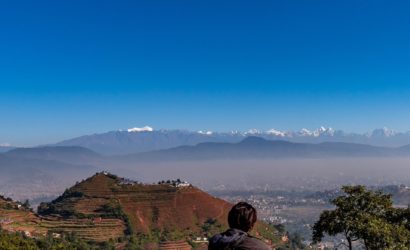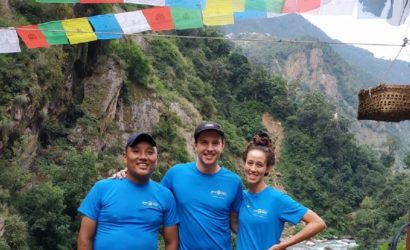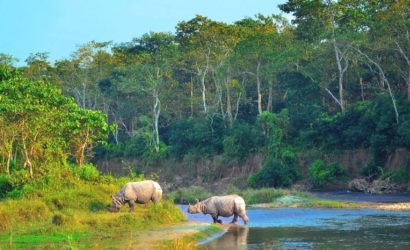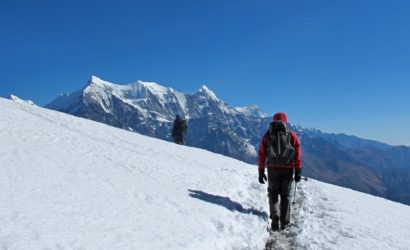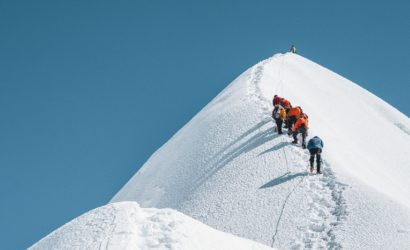The ultimate adventure of 14-days Everest Base Camp Trek offers breathtaking mountain panoramas, if you like to walk this is one of the most inspiring places in the world to do it.
The tallest summit of the earth standing tall at a height of 8,848 meters is not only the aspiration of mountaineers from all over the world, but its base camp, Everest Base Camp is also one of the most popular and rewarding trekking destinations. More than 30,000 trekkers trek to this region every year.
Our 14-days Everest Base Camp Trek is a great introductory lodge trek that offers sensational mountain views and an insight into the lives of the Sherpa people. Everest Base Camp trek trail follows the trail for the Mount Everest expedition till the base Camp.
After discovering the temples, shrines, bazaars and restaurants of Kathmandu we take an exciting mountain flight to Lukla and trek up the Dudh Kosi Valley, surrounded by the soaring peaks of Thamserku and Kusum Kanguru. It’s a steep ascent to Namche Bazaar, the capital of the Kumbu Sherpas, where we are again greeted by spectacular mountain vistas.
A rest day here aids acclimatization and there are great optional walks to enjoy the area. We then follow the trail to famous Tengboche, located high on a ridge where a magnificent 360-degree panorama awaits. The views of Everest, the Lhotse-Nuptse Wall, Ama Dablam and Kantega dominate this peaceful and spiritual location – surely one of the most tranquil and inspiring places in the world.
The Everest Base Camp Trek is not only famous for its nearness of world’s highest peak but also for its friendly Sherpa people, world’s highest Buddhist monasteries, picturesque Sherpa villages, great variety of cultures, traditions and active Buddhist monasteries.
This stunning Everest Base Camp trekking visits both, Everest base camp and Kala-patthar (5645 meters), a viewpoint recognized as the best vantage point to see Mount Everest which is a premier goal for many adventurous walkers in the Himalaya.
14-Days Everest Base Camp Trek Difficulty
Firstly, it should be noted that no climbing expertise is required for the Everest Base Camp Trek and there are no technical climbing sections.
Many people believe that a super high fitness level is required for the EBC trek. While a good fitness level will certainly make the trek more enjoyable, you definitely don’t have to be an Olympic athlete.
An EBC trek tires most people due to the altitude and hilly nature of the path, but we think that any novice-trekker can tackle the hike with a little basic training.
Certainly some days are easier than others, and preparing for the tough days is sensible, not the easy ones. If you have minimal fitness, walking to EBC for 4 to 6 hours a day will bring it out of you.
Everest Base Camp Trek difficulty, the altitude is undoubtedly the most difficult and underestimated aspect of the EBC trek. Certainly, the trek’s high altitude profile makes it going more difficult.
If it wasn’t for altitude, the EBC trek would actually be very basic. Acute Mountain Sickness (AMS), especially at altitudes reached on the EBC trek, should not be taken lightly or underestimated.
We advise you do a couple of 4 – 6 hour treks at home so that your body is used to that kind of exercise period. Start about 5-7 weeks in advance, and slowly build up time and distance so that you can walk a strong 5-hours trekking time.
Best Season for 14-Days Everest Base Camp Trek
From September to November (autumn) and March to May (spring) are the best season to trek to Everest Base Camp. June to August (monsoon) is the rainy months but this time is best for keen botanists and has clear sky sometimes. During the hike, it offers grand spectacles of blooming rhododendron flowers during months of March, April and May.
The view of Mt. Ama Dablam with the rising sun shining on it is one of the superb views of this trek. At the highlight of this trek, you will climb Everest Base Camp and Kala Patthar at dawn to enjoy one of the most brilliant mountains views on the Earth. If you want to avoid crowds then winter trekking (December – February) is recommended.
The morning temperature is cold but not unbearable and during the day it is warm and clear sky with a fantastic view for most days.
14-Days Everest Base Camp Trek Packing List
1. Base Layer 2. Trekking Shirts 3. Trekking Trousers and Shorts. 4. Fleece Jacket 5. Insulated Jacket 6. Hard Shell Jacket and Rain Gear 7. Sun Protection Hat 8. Trekking Backpacks 9. Camera Gear and Accessories 10. Hiking Boots and Socks 11. Jackets and Other Outerwear 12. Long Underwear and Base Layers 13. Gloves, Hats, and Rain Gear Other Essentials.
It is advisable to use good quality worn-in boots to protect your feet. For more detail check out here
Food 14-Days Everest Base Camp Trek
Everest Base Camp Trek is in the mountainous region, so you should not expect to find a variety of western food. Yet you’ll for sure taste authentic Sherpa, Tibetan and Nepali food on this trip.
Also, it would be best if you avoided eating meat dishes during the journey as it is not fresh and hygienic. Because animal slaughtering is prohibited in the Everest region, any meat available there is transported by yak or porter from Kathmandu or Kharikhola.
However, the vegetarian meals served in the home-stays are both nutritious and delicious, and it gives you enough energy to complete a day hike. Every day, you will be served a different breakfast and lunch menu.
14-Days Everest Base Camp Trek Cost
The Everest Base Camp Trek cost anywhere between $1350 and $2000, depending on the services, outfitter, and route. And our 14-days Everest Base Camp Trek is more affordable compared to other trek packages.
Our package includes a guide, meals, accommodation, a porter, and other services. However, it does not cover your personal expenses, so bring between $12 and $18 for each day of the trek.
Be sure to carry the cash because they do not have money exchanges, ATMs, or banks except Lukla and Namche. You’ll need cash to pay for things like bar bills, hot showers, snacks, phone or camera charging, and so on.
Accessing 14-Days Everest Base Camp Trek
The Everest Base Camp Trek starts at Lukla and leads you through the Khumbu Valley to the Everest Base Camp situated on the south side of Mount Everest.
Most trekker’s however, begins in Kathmandu. From there it is a short, yet unforgettable flight into Lukla 30mins from where you will start the actual trekking.
The entire journey including the trek typically lasts between 14 and 16 days, with 12 days on the trail. Of these 12 days, 2/3 will be spent acclimatizing to the high altitude, so 10 days of actual trekking can be expected.
For those who don’t want to start their trek by flying into Lukla Airport, the Jiri to Everest Base Camp Trek variation provides a unique alternative.
This trek starts with a bus ride from Kathmandu via Jiri to Deurali/Bhandar from where the trekking starts. Because Jiri is considerably further away than Lukla, this variation will add around 5 to 6 days into the trek.
14-Days Everest Base Camp Trek: Highlights
- Visit Everest Base Camp and experience the camaraderie as climbers attempt the world’s highest peak
- Highly experienced Sherpa leaders
- Stand on the summit of Kala Patar at 5,645 m. (18,519 ft) for stunning views of Everest
- Visit ancient monasteries and receive a blessing from a monk/lama
You will arrive at Kathmandu where we will pick you up from TIA and drop you to the hotel. Meanwhile, you can take your time to stroll around to visit the temples and monuments.
There are plenty of places that you will find fascinating if you wander around. In the evening you will have dinner and stay overnight at the hotel.
Everest Base Camp trekking adventure starts on the second day with a scenic flight from Manthali Airport, Ramechhap or Kathmandu Airport to Tenzing Hillary Airport at Lukla (2,804 m).
Upon arrival at Lukla, you will meet our porters who will carry your luggage bags. After a short glimpse of Lukla village, the Everest Base Camp hike commences, where you will pass Chaurikharka village, then descend towards Dudh Koshi Ghat. From there, you follow the trails via Dudh Koshi River bank to Phakding and stay overnight at a guest house.
Please note: Kathmandu to Lukla flight has been shifted to Manthali airport, Ramechhap in peak trekking season Spring (March, April, May) and Fall (September, October, November) due to increased traffic as well as renovation in Kathmandu airport since March 2019. Manthali airport can be reached within 4 to 6-hour drive in road from Kathmandu.
This means you need to wake up early in the morning around 2:30 am to go for a drive and catch your early morning Lukla flight from Manthali.
Early in the morning, you will have your breakfast and then begin your trek to Namche Bazaar. You will walk 7.4 km from Phakding to Namche Bazaar.
You begin walking through the beautiful forest of rhododendron and cross Hillary Suspension bridge before you enter the Namche Bazaar.
After you reach the village of the Sherpas, you will rest and have your meals. You can take your time to stroll around and meet the locals. You will see the local yaks as a means of transportation there. You will also witness the head of the dominant mountain, Nupla.
You will stay overnight at Namche Bazaar.
The fourth day is the acclimatization day. This means that your body needs to adapt to a new environment. So, you need to take a day break so that you can adjust to a completely new altitude of Namche Bazaar.
The acclimatization only takes a short time for your body to get adjusted. Meanwhile, you can take your time to wander around the beautiful village.
You can know some more about the lifestyles and people there. You might get the chance to see Mount Sagarmatha from here if the weather is clear.
The simplicity of the Sherpas is something that you will remember for a very long time. You can take your time to visit the Sagarmatha National Park and Sherpa Museum.
You will spend the night there at Namche Bazaar.
Early in the morning, you will leave for Tengboche. You will pass through the banks of the Dudh Koshi river to reach Tengboche. You will also get to visit the local monasteries.
You will enjoy the views while trekking and the water resources will freshen up your mood. After only a short trek, you will see a clear view of the mountains. If you are early, you can also take your time to visit a military museum on the way.
After reaching Tengboche, you will have your meals and stay there for the night.
Early morning, you will walk down to Indrakhola and climb up to Dingboche. At the height of 4360 m, you will see the gorgeous view of Mt. Lhotse and also the striking Mt. Ama Dablam.
You will also see a clearer view of Everest on the trek from Tengboche to Dingboche. It is a sight to cherish.
This place will also be a spot for you to take a rest and for the second acclimatization. You can take your time to get adjusted for a while and also enjoy the view. This spot is also considered to be among the best viewpoint in the region. You will stay there the night.
You will walk through the base of Mt. Lobuche. This is yet the most difficult part of the trekking journey. The roads are a bit harder to walk on in the higher altitudes.
The trails are completely safe. But, do take your time and maintain your pace with it and not hurry. You will stay overnight in Lobuche.
On the eighth day, you will walk towards the Everest Base Camp from Lobuche.
You will walk through the highest glacier of the world, Khumbu Glacier. The views of the pristine mountain are absolutely captivating when you are surrounded by the icy glacier.
After walking for about 7 hours, you will reach Everest Base Camp.
After your time at the Base Camp, you will again head back for Gorakshep where we will rest and spend the rest of the day.
Although Everest Base Camp might seem like the last destination for you but the views from Kalapatthar are spectacular.
Yes, you will trek up to Kalapatthar from where you can have the best view of Mount Sagarmatha.
So, enjoy the view while you can. And you will climb down to Lobuche for lunch and head to Pheriche where you will spend the night.
After breakfast, like every other day, you will prepare yourself to leave Pheriche. From Pheriche to Debuche and then an hour climbs to Tengboche once again.
You will again descend to Phunkithanga (3200 m) and finally, hike towards Namche. After days of hard work and after a feeling of accomplishment, we will enjoy at Namche.
After days of adjusting, enjoy the variety of food at Namche. Because this is a transit point, it is a settlement that has prepared to adjust to the growing number of tourists. Which is why it is quite facilitated. Enjoy the day and rest well. Overnight at guesthouse.
The trail from Namche to Lukla follows a steeply downwards path passing a suspension bridge. Here, The Dudh Koshi River comes up with a gorgeous feel to the natural surroundings.
This is the last destination and tomorrow you will head to Kathmandu. Overnight at guesthouse.
Early in the morning we will catch a scenic flight back to Kathmandu or Manthali over the Himalayas. Arrive at Kathmandu and, back to the hotel. You can take a rest or spend the rest of your day strolling around Thamel.
It’s a spare day in case of bad weather in Lukla.
It’s an extra spare day in case of bad weather in Lukla. If you get interested to take some gifts from Nepal for friends and relatives, visit to some nearby shops or go out in Thamel for typical Nepalese goods which can be assisted by our guide or you can do it yourself too.
Optional activities: You may wish to visit Durbar Square in the heart of the old city where the old Royal Palace, with its intricate woodcarving is located. The whole area is a maze of temples and images. Leading away from the square in all directions are narrow alleys, full of the most amazing variety of shops and stalls. Some of these landmarks are considered World Heritage Sites including the historic Bhaktapur Durbar Square, the famous ‘Monkey Temple’ Swayambhunath and Buddhists shrine Buddhanath which is one of the largest Stupas in the world.
In the evening we will have a farewell dinner in a traditional Nepalese restaurant with cultural performances.
The trip concludes! Our airport representative will drop you to the Kathmandu International Airport for your flight departure from Nepal.



